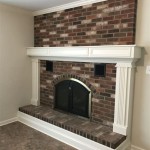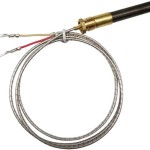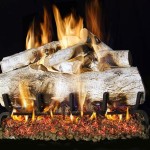DIY Faux Fireplace Mantel: A Comprehensive Guide
A fireplace often serves as a focal point within a living space, radiating warmth and visual appeal. However, not every home is equipped with a functional fireplace. For individuals seeking the aesthetic benefits without the expense or complexity of installing a traditional fireplace, a DIY faux fireplace mantel presents a viable and attractive alternative. This article provides a thorough guide to constructing a faux fireplace mantel, covering design considerations, material selection, construction steps, and finishing techniques.
Planning and Design Considerations
Before embarking on the construction process, careful planning is essential. This stage involves determining the desired style, dimensions, and location of the faux fireplace mantel. Consider the existing architectural style of the room and select a design that complements it. A rustic aesthetic may suit a farmhouse-style home, while a sleek, minimalist design may be more appropriate for a modern interior. Accurate measurements of the intended location are crucial to ensure a proper fit and prevent any future issues.
The dimensions of the faux fireplace mantel should be proportional to the room's size and the surrounding furniture. A mantel that is too large can overwhelm the space, while one that is too small may appear insignificant. A general guideline is to consider the height of the ceiling and the width of the wall where the mantel will be placed. A mantel height between 48 and 54 inches from the floor is typical, but this can be adjusted based on personal preference and the specific layout of the room. The width of the mantel should extend slightly beyond the width of the faux firebox opening, typically by a few inches on either side.
Furthermore, consider the intended use of the mantel. Will it primarily serve as a decorative element, or will it be used to display items such as picture frames, candles, or books? This will influence the depth of the mantelpiece and the overall design. If the mantel is intended for display purposes, a deeper mantelpiece will provide more surface area. Also, consider whether you intend to add a "firebox" within the mantel. This can be simulated using electric logs, candles, or even creative lighting. Ensure the design accommodates this element if desired. Finally, consider safety. If using candles or electric logs, ensure adequate ventilation and follow all safety guidelines.
Material Selection and Procurement
The choice of materials significantly impacts the final appearance and durability of the faux fireplace mantel. Common material options include wood, MDF (medium-density fiberboard), and reclaimed materials. Each material offers its own set of advantages and disadvantages. Wood provides a classic and timeless aesthetic, offering a wide range of species to choose from, each with its own grain patterns and color variations. Popular choices include pine, oak, poplar, and maple. Pine is a relatively inexpensive and readily available option, while oak is known for its strength and durability. Poplar is a good choice for painting, as it has a smooth surface and takes paint well.
MDF is an engineered wood product that is known for its smooth surface and dimensional stability. It is less prone to warping or cracking than solid wood, making it a suitable option for painted mantels. MDF is also relatively inexpensive and easy to work with, making it a popular choice for DIY projects. However, it is not as strong as solid wood and should be handled with care to avoid damage.
Reclaimed materials, such as old barn wood or pallet wood, can add character and a rustic touch to the faux fireplace mantel. Reclaimed wood often has unique markings and imperfections that contribute to its visual appeal. However, it is important to carefully inspect reclaimed wood for any signs of rot, insect infestation, or other damage before using it in a project. Reclaimed wood may require additional preparation, such as sanding or cleaning, to remove any dirt or debris.
In addition to the primary building material, other materials may be required, such as screws, nails, wood glue, sandpaper, paint, primer, and sealant. Ensure that all necessary materials are gathered before starting the construction process to avoid any interruptions.
Construction Steps
The construction of a faux fireplace mantel involves several steps, including cutting the materials to size, assembling the frame, attaching the mantelpiece, and adding any decorative elements. Precision and accuracy are crucial throughout the construction process to ensure a professional-looking result.
Begin by cutting the chosen material to the dimensions determined during the planning phase. Use a saw to cut the pieces accurately, ensuring square cuts for a clean and professional finish. If using power tools, always wear appropriate safety gear, such as safety glasses and ear protection. Once the pieces are cut, dry-fit them together to ensure that they fit properly before proceeding with the assembly.
Assemble the frame of the faux fireplace mantel using screws, nails, and wood glue. Wood glue provides a strong and durable bond, while screws and nails provide additional support. Apply wood glue to the joints before fastening them together. Use clamps to hold the pieces in place while the glue dries. Ensure that the frame is square and level before proceeding to the next step. A framing square can be used to check for squareness.
Attach the mantelpiece to the frame using screws and wood glue. The mantelpiece is the horizontal shelf that sits on top of the frame. It can be made from the same material as the frame or from a different material to create a contrasting look. Ensure that the mantelpiece is flush with the frame and securely fastened. Fill any screw holes with wood filler and sand smooth.
Once the basic structure is complete, add any desired decorative elements, such as molding, trim, or corbels. These elements can enhance the visual appeal of the faux fireplace mantel and add character to the design. Attach the decorative elements using nails, glue, or screws, depending on the size and weight of the elements. Ensure that the decorative elements are securely attached and properly aligned.
Consider adding a back panel constructed from plywood or decorative boards to fill the space behind the mantel. This element can further enhance the fireplace illusion and create a cohesive design.
Finishing Techniques
The finishing touches are crucial for transforming a basic faux fireplace mantel into a visually stunning focal point. This involves sanding, priming, painting, and sealing the surface to achieve the desired aesthetic and protect the material.
Begin by sanding the entire surface of the faux fireplace mantel to create a smooth and even finish. Use a fine-grit sandpaper, such as 220-grit, to remove any imperfections or rough edges. Sand with the grain of the wood to avoid scratching the surface. After sanding, wipe down the surface with a damp cloth to remove any dust or debris. A tack cloth can also be used for this purpose.
Apply a primer coat to the entire surface of the faux fireplace mantel. Primer helps to seal the surface and provide a better base for the paint to adhere to. Choose a primer that is compatible with the chosen paint. Apply the primer evenly using a brush, roller, or sprayer. Allow the primer to dry completely before proceeding to the next step.
Apply two or more coats of paint to the faux fireplace mantel, allowing each coat to dry completely before applying the next. Choose a paint color that complements the room's decor. Apply the paint evenly using a brush, roller, or sprayer. For a smooth finish, consider using a high-quality paint and applying thin coats. Lightly sand between coats of paint with a fine-grit sandpaper to remove any imperfections.
After the paint has dried completely, apply a sealant to protect the surface and enhance its durability. Sealant helps to prevent scratches, stains, and other damage. Choose a sealant that is compatible with the chosen paint. Apply the sealant evenly using a brush, roller, or sprayer. Allow the sealant to dry completely before using the faux fireplace mantel.
For a more rustic look, consider techniques like distressing or antiquing the painted finish. Distressing involves sanding away some of the paint to reveal the underlying wood or primer, while antiquing involves applying a glaze or stain to create a aged appearance.
Installation and Safety Precautions
Once the faux fireplace mantel is complete, it is time to install it in the desired location. Proper installation is crucial to ensure that the mantel is securely attached to the wall and does not pose a safety hazard.
Locate the wall studs in the area where the faux fireplace mantel will be installed. Use a stud finder to locate the studs accurately. Mark the location of the studs on the wall. The faux fireplace mantel should be attached to the wall studs for maximum stability. If the studs are not in the ideal location, consider using drywall anchors to provide additional support. However, attaching to studs whenever possible is the most secure method.
Position the faux fireplace mantel against the wall and align it with the marked stud locations. Use a level to ensure that the mantel is level before attaching it to the wall. Drill pilot holes through the frame of the mantel and into the wall studs. Use screws to attach the mantel to the wall studs. Ensure that the screws are long enough to penetrate the studs securely.
If using drywall anchors, follow the manufacturer's instructions for installing them. Drill holes in the wall at the desired locations and insert the drywall anchors. Then, use screws to attach the mantel to the drywall anchors.
Ensure that the faux fireplace mantel is securely attached to the wall before placing any items on the mantelpiece. Regularly inspect the mantel for any signs of loosening or damage. If any issues are detected, address them promptly to prevent any accidents. When using candles or electric logs within the 'firebox', maintain a safe distance between flammable materials, and never leave unattended.

How To Make A Faux Fireplace Mantel Surround Shiplap And Ss

Easy Diy Faux Fireplace And Mantel Zucchini Sisters

Diy Faux Fireplace Mantel With Tile And Brick

Diy Faux Fireplace For Under 600 The Big Reveal Bless Er House

Diy Faux Fireplace Mantel Tutorial Grace In My Space

How I Built A Faux Modern Farmhouse Fireplace Anderson Grant

Diy Faux Fireplace Mantel Rebecca Propes Design

How To Build A Mantel 40 Bucks Faux Fireplace Diy

Diy Faux Fireplace Mantel With Tile And Brick

How To Turn A Bookshelf Into Faux Fireplace Mantle Miss Mustard Seed S Milk Paint
Related Posts








